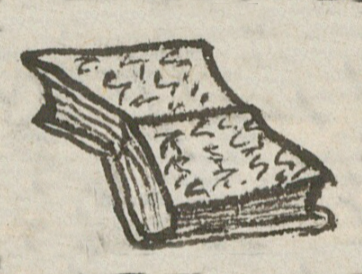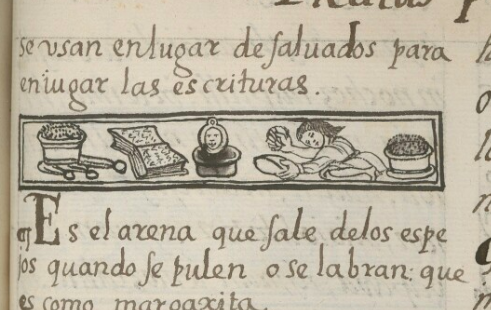tlacuilolli (FCbk11f216r)
This black-line drawing of an open book is apparently a simplex glyph that mirrors the term in the text, “in tlacuilolli” (a piece of writing). The parallel text in Spanish refers to “escrituras” (pieces of writing). This was also a loanword taken into Nahuatl. As shown, the book is open to about the middle, and three or more rows of squiggly lines on each of the two visible pages suggest either handwriting or typeface.
Stephanie Wood
The pre-contact book was screenfolded, so this type of book was a European colonial introduction. The many examples below of books show the wide array of Nahual terminology that could apply. Books often had associations with the Catholic church, as something priests might hold while giving mass or when instructing the doctrine. Or, church singers might hold books while they sang, for example. The paper could be European or Indigenous (amatl).
Marc Thouvenot identifies the verb icuiloa (or ihcuiloa, with the glottal stop), which means to paint, write, or print, as having a root of -cuil-. He notes how it also appears in tlacuiloliztli (writing), tlacuilo (writer), and cuicuiltic (mottled). He goes on to show various uses of icuiloa that take it beyond the simple definitions just given, resulting in something like the action of creating a design (e.g., on leather, ceramics, sculpture, or in textiles). It can also be something like the action of decorating (e.g., to put a flower on a cup of atole). He associates icuiloa and tlacuilolli with "cultural artifacts," such as arts and crafts or examples of writing and painting, but cuicuiltic with effects created by "nature." This short summary barely does his article justice; it is worth reading the entire piece. How Thouvenot's study might connect with the concept of bent or curved mentioned by Prem (1974: 555, 682) raises an interesting question. Perhaps the bent or curved lines of writing, painting, carving, embroidery, and so on, fall with in the realm of expressions of -cuil-. See
Marc Thouvenot, "Imágenes y escritura entre los nahuas del inicio del XVI," Estudios de Cultural Náhuatl 41 (2010).
Stephanie Wood
escrituras.
escrituras
Stephanie Wood
1577
Jeff Haskett-Wood
escritura, libro, libros, papeles, psalterios, papel, cantores

tlacuilol(li), anything written or painted, https://nahuatl.wired-humanities.org/content/tlacuilolli
escritura (a loanword from Spanish taken into Nahuatl), a document, https://nahuatl.wired-humanities.org/content/escritura
la escritura
Stephanie Wood
Available at Digital Florentine Codex/Códice Florentino Digital, edited by Kim N. Richter and Alicia Maria Houtrouw, "Book 11: Earthly Things", fol. 216r, Getty Research Institute, 2023. https://florentinecodex.getty.edu/en/book/11/folio/216r/images/a43c572b-... Accessed 19 June 2025.
Images of the digitized Florentine Codex are made available under the following Creative Commons license: CC BY-NC-ND (Attribution-NonCommercial-NoDerivs 4.0 International). For print-publication quality photos, please contact the Biblioteca Medicea Laurenziana ([email protected]). The Library of Congress has also published this manuscript, using the images of the World Digital Library copy. “The Library of Congress is unaware of any copyright or other restrictions in the World Digital Library Collection. Absent any such restrictions, these materials are free to use and reuse.”









